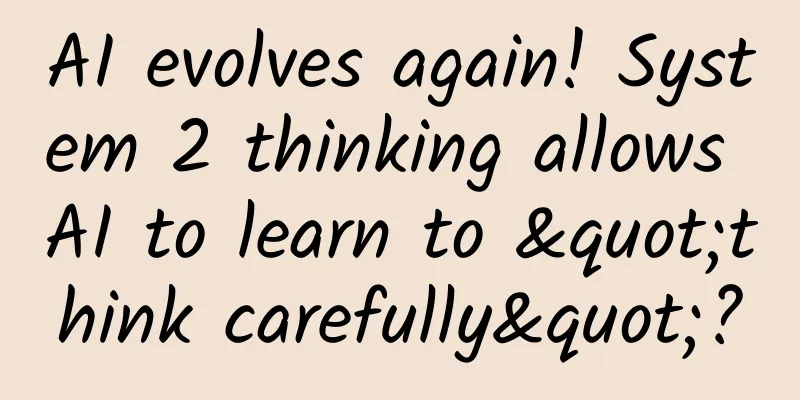AI evolves again! System 2 thinking allows AI to learn to "think carefully"?

|
If you ask which research direction in the field of artificial intelligence has been popular in recent years, it must be large models. With the launch of the ChatGPT product by OpenAI at the end of 2022, the commercialization process of artificial intelligence around large models has entered the fast lane, profoundly changing the production methods and service models of various industries. According to data from market research firm Precedence Research, the global artificial intelligence market size reached approximately RMB 1,187.9 billion in 2023, and is expected to soar to RMB 11,455.4 billion by 2030, achieving a compound growth rate of more than 35%. However, it should be pointed out that model training requires massive amounts of data, including text, images, and voice, and during the training process, the model parameters may need to be adjusted to optimize performance and improve accuracy, which requires strong computing power to provide support. Data shows that the cost of a complete model training of ChatGPT exceeds 80 million yuan. If 10 complete model trainings are conducted, the cost will be as high as 800 million yuan, which has obviously become a major obstacle to the development of large models. However, recently, Noam Brown, a senior scientist at OpenAI, proposed a striking theory that provides a new way to solve this problem. He said that if the AI model thinks for 20 seconds before each decision, its performance improvement is equivalent to increasing the model size and training time by 100,000 times, and "System 2 thinking" is the key to achieving this breakthrough. A new mindset The concept of System 2 thinking originated in psychology and was proposed by Nobel Prize winner Daniel Kahneman. The theory holds that human thinking is driven by two distinct systems. System 1 thinking is fast, intuitive, and automatic, controlling our quick judgments, such as reactions to unexpected events or recognition of familiar patterns. In contrast, System 2 thinking is slow, deliberate, and analytical, supporting complex problem solving, planning, and reasoning. Although these two systems are often treated separately, they are constantly interacting. System 1 thinking generates impressions, intuitions, and intentions; System 2 thinking evaluates suggestions and, if it agrees, integrates them into considered choices. This allows humans to seamlessly navigate a wide range of situations, from everyday life to challenging problems. Brown introduced this theory into the field of AI, and advocated that by prompting AI to conduct deeper analysis and reasoning, the performance of the model can be significantly improved without significantly increasing resources. Specifically: First, improved reasoning and problem-solving skills. Large models with System 2 thinking will perform better at logical reasoning, understanding complex concepts, and solving problems that require careful thought and consideration. This may include everything from advanced math problem solving to more subtle moral reasoning. Second, improved understanding of context and nuance. Current big models can have trouble understanding context and nuance, especially in complex or ambiguous situations. System 2 thinking will enable big models to better grasp the subtleties of human language and the complexity of real-world scenarios. Third, reduce bias and error. While System 1 thinking is responsive, it is also more susceptible to bias and error. By incorporating System 2 thinking, big models have the potential to reduce these biases, leading to more fair and accurate results. Fourth, better decision making. In fields such as business or medicine, where decisions often have significant consequences, large models with System 2 thinking can analyze large amounts of data, weigh different options, and make decision recommendations based on logical reasoning and evidence. Fifth, enhanced learning and adaptability. System 2 thinking in large models may lead to improved learning capabilities, enabling it to not only learn from data but also understand and apply abstract concepts, principles, and strategies in a variety of situations. Sixth, more effective human-machine collaboration. With System 2 thinking, the big model can better understand and predict human needs and behaviors, leading to more effective and intuitive human-machine interaction and collaboration. Future development is promising It is worth noting that achieving true System 2 thinking in the field of AI is a major challenge. This requires not only improved algorithmic methods and computing power, but also a better understanding of human cognitive and reasoning processes. So far, large models mainly operate in a way that is closer to human System 1 thinking, relying on pattern recognition and rapid response generation rather than deep logical reasoning. But we also see that some technology companies have taken the step of exploration. For example, the o1 model launched by OpenAI incorporates system 2 thinking, which enables AI to perform a more in-depth reasoning process. It is reported that in the International Mathematical Olympiad Qualifying Examination, the accuracy rate of this model is as high as 83%, far exceeding the 13% of the current mainstream model. Also worth noting is the Talker-Reasoner framework launched by DeepMind. This framework combines two thinking modes. Among them, the Talker component is responsible for handling real-time interactions with users and the environment, perceiving observations, interpreting language, retrieving information from memory, and generating dialogue responses. The Reasoner component is responsible for performing complex reasoning and planning, and interacting with tools and external data sources to increase its knowledge and make wise decisions. We believe that by simulating the human deliberation process, large models can not only improve their problem-solving capabilities, but also better understand and adapt to complex and changing environments. This progress is not limited to the expansion of applications in the field of technology, but also means more humane and efficient services in more industries. In conclusion: It is no exaggeration to say that the integration of System 2 thinking into big models marks a critical moment in the evolution of AI. It is foreseeable that with the widespread application of big models, it will help us solve more complex problems, provide more accurate services, and promote human society into a new intelligent era. Source: Chongqing Tianji Network Co., Ltd. Audit expert: Li Zhigao Statement: Except for original content and special notes, some pictures are from the Internet. They are not for commercial purposes and are only used as popular science materials. The copyright belongs to the original authors. If there is any infringement, please contact us to delete them. |
<<: Is lupus, the “immortal cancer”, a terminal illness?
>>: This vegetable absorbs a lot of oil, but it is very suitable for losing weight!
Recommend
How to build an e-commerce product cognition system?
E-commerce is an indispensable industry in our li...
2017 Baidu Alliance Summit: Robin Li proposed new thinking in the AI era
The "new generation of technological revolut...
E-commerce operations: Why are there more and more e-commerce festivals?
Nowadays, there are more and more e-commerce carn...
105-year-old IBM is overwhelmed by reform. Can artificial intelligence save it?
Some companies embrace reform, while others are o...
Helicobacter worms found in bananas that kill within 72 hours? Is this a fungus or a worm?
Recently, news about "bananas containing a w...
How to plan a new media marketing promotion plan?
What role does new media marketing play? How to s...
E-commerce operation: How can merchants make good arrangements for the Double 12 promotion nodes?
I believe that many small and medium-sized seller...
Can Samsung reverse its decline by borrowing Nokia’s model?
Recently, Samsung's channel strategy in the C...
How to get more customers smartly?
If we divide the company's customer base base...
How to promote APP? APP promotion tips!
Mobile devices have become the most important too...
Sohu Video finally invests 100 million yuan to build the first VR content ecosystem
2016 is the first year of VR (virtual reality), a...
How to operate a WeChat public account from scratch?
Post an article once, lose followers once This is...
Why do I recommend that you really dry your quilt regularly?
Among all animal phobias, spider phobia is defini...
How to effectively promote the product in the early stage?
"Successfully executing a plan that makes no...
Why are genes the key to inheritance? The Human Genome Project deciphers the code of life
Prelude to the birth of gene editing - DNA has al...








![[Smart Farmers] High folic acid corn makes you eat "healthier"](/upload/images/67f22f62e32e9.webp)
